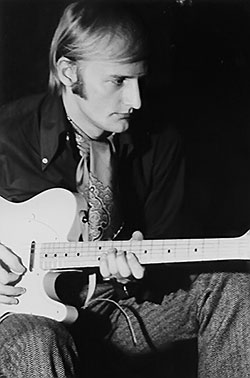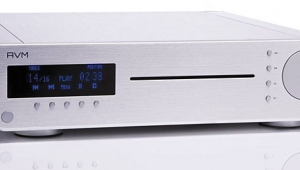| Columns Retired Columns & Blogs |
The Fifth Element #92

Chris Huston is as soft-spoken and unassuming a chap as you would ever hope to meet, a real gentleman of the old school. He also has an amazing backstory. He and John Lennon were close friends at Liverpool's College of Art, and later had "dueling bands" that played at Liverpool's Cavern Club. Huston's band was the Undertakers, with lead singer Jackie Lomax. Like the Beatles, the Undertakers spent time playing gigs in scrappy clubs near the Hamburg docks. However, Huston is not just an asterisk in the music encyclopedias. He co-engineered Led Zeppelin's II, earned a Grammy for producing War's The World Is a Ghetto, and has produced and/or engineered more than 80 gold and platinum records.
Footnote 1: Wilson Benesch Ltd., Falcon House, Limestone Cottage Lane, Sheffield S6 1NJ, Yorkshire, England, UK. Tel: (44) (0)1142-852656. Web: www.wilson-benesch.com. US distributor: The Sound Organisation, 159 Leslie Street, Dallas, TX 75207. Tel: (972) 234-0182. Fax: (972) 234-0249. Web: www.soundorg.com.
 Huston and I were discussing loudspeaker design when he asked a question that brought me up short: "Should a loudspeaker have a personality?"
Huston and I were discussing loudspeaker design when he asked a question that brought me up short: "Should a loudspeaker have a personality?"
It took me a moment to collect my thoughts—I had never thought of things in quite those terms. I quickly ransacked my memory for peak audio experiences, then said, "Yes."
Huston's reply is one of the most concise and insightful bits of audio wisdom I have ever heard: "A loudspeaker without a personality is like a song without a hook."
But it sounds as counterintuitive as it is bound to be controversial. Shouldn't we want speakers to sound as neutral as possible—that is, to have no personality? Shouldn't a speaker be the acoustical equivalent of "a straight wire with gain"? In theory, yes.
In practice, however, the laws of physics seem to dictate that, in designing a loudspeaker, to get this, you have to give up that. You squeeze it here, it bulges there. Pick your poison. In speaker design, there's always something you give up—even if it's only affordability. We use speakers not in anechoic chambers but in actual rooms of actual houses, to listen not to sinewave test tones, but to imperfect recordings of music.
At some point, speaker designers must nail their colors to the mast and let the world hear what they think a speaker should sound like. And that's what that speaker's personality is.
But do loudspeakers need personalities? I think Chris Huston was right. Too often, the price you pay for neutrality is subliminal disconnection from the music.
For many years, I've been a fan of the loudspeakers made by the British audio company Wilson Benesch (footnote 1). Their speakers definitely have their own personality. I first reviewed a Wilson Benesch loudspeaker while a columnist and reviewer for The Abso!ute Sound, and how that came about was amusing. As WB's then US importer was packing up his exhibit at the 1999 Consumer Electronics Show, by mistake he put labels with my address on them on the boxes containing the show samples of WB's revolutionary A.C.T. One, the first loudspeaker to have a curved carbon-fiber enclosure, a sloping top, and a baffle of cut steel. And a very nice late Christmas present they were, too.
My comments on the A.C.T. One ran in the August/September 1999 TAS, issue 119. I praised it to the skies; even Harry Pearson himself had to admit that, had he not listened to the A.C.T. One (which at the time cost ca $10,000/pair), he would not have been able to "put his finger on" what was not quite right in the midrange of a ca $80,000/pair speaker prominently featured in that issue.
Of all the audio equipment I've heard in my three decades as an audio writer, the A.C.T. One and darTZeel's NHB-108 stereo power amplifier tie for first place in terms of my regret at not having bought them. Enlightened Audio Designs' Ultradisc 2000 CD player is in second place. It's telling that A.C.T. Ones rarely seem to come up for sale on eBay or Audiogon.
In 2000 I moved from TAS to Stereophile, and in September 2004 I wrote of the A.C.T. One's successor, the ACT, "The hallmarks of Wilson Benesch's 'house sound' are extremely low distortion, seamless coherence, unfussy easefulness, rounded liquidity of tone, articulate dynamics, and seductively natural imaging and soundstaging." For what many might perceive as American tastes, I also had to note that WB's house sound favored elegant bass quality over bass quantity, and further, that the combination of high tech and high style meant that WB speakers, tier by tier, cost more than those of their built-in-the-US competition.
So, despite a small but committed fan base, a sprinkling of committed dealers, lots of respect, and some great reviews, Wilson Benesch's presence in the US market has not been uninterrupted. In 2014, WB reconnected with Steve Daniels of The Sound Organisation, importers of Rega Research and other brands. Together, they've been rebuilding WB's US dealer base, starting with the Series II edition of WB's entry-level speaker, the petite, rectilinear, non–carbon-fiber Square One.
I had a wide-ranging conversation with Wilson Benesch's owners, Christina and Craig Milnes, who believe that their company offers to audio-enthusiast music lovers a unique combination of values and benefits. First, their speakers embody 25 years of fundamental research in materials science, much of it funded by Her Majesty's Government. They have in-house control over the complete manufacturing process. Then there's WB's design aesthetic, revolutionary 20 years ago but since picked up by others. Finally, they offer a sound quality they feel is different from that of any other speaker company. "Voicing a loudspeaker is a very personal thing, I think," Craig told me.
Craig Milnes stated that the Square One is the least-expensive speaker WB can make without deviating from their technical, aesthetic, and sound-design heritage—that it is, in fact, at $3800/pair, something of a loss leader. That said, he thinks that the Square Five ($17,000/pair) is their highest-value product, in that all of its technology is borrowed from WB's flagship model, the Cardinal ($115,000/pair). The Cardinal has sold even better than was hoped, especially in Germany, about which the Milneses pronounce themselves "more than happy." Christina noted that the entry-level Square One boasts the Cardinal's quality of veneer, from the same supplier.
Wilson Benesch Series II Square One
Wilson Benesch's Series II Square One is a stand-mounted, dynamic loudspeaker measuring 12.8" high by 8" wide by 11.2" deep and having an internal volume of 10 liters. A vented two-way design, it has a 1" soft-dome tweeter, a 7" mid/woofer, and, on the rear panel, a 7" Assisted Bass Radiator (ABR or passive radiator). Unusually, both ports vent through the bottom panel. Therefore, the speaker enclosure has, at the four corners of its base, metal standoffs. These can be covered with small, compliant, self-adhesive hemispheres (supplied) for installation on a bookshelf or sideboard. Alternatively, the standoffs accept the supplied hefty machine screws, installed upward through holes in the dedicated, all-metal stands. The stands cost $1395/pair, for a total system cost of $5195/pair.
Securely locking a loudspeaker to its stand is a concept I heartily endorse. One doesn't want toddlers to pull speakers down on top of themselves by their cables. Nor does one want an adult guest to inadvertently hip-check one's speaker onto the floor.
In addition to the unusual combination of bottom ports and ABR, the Square One's design includes "critical mass damping pads." A Square One on its own weighs 22 lbs; each hefty spiked stand (available only in black, front spikes permanently attached) weighs 26 lbs. The standard finishes are Natural Cherry Stain; or, in Gloss, Black, White, Birds Eye, Red Birds Eye, Red Tulip, Walnut, Burr Walnut, Ebonized Walnut, and Zebrano; or, in Satin, Maple and Oak. The review pair was in Ebonized Walnut Gloss, which looked almost black, except in full daylight.
The fit and finish were second to none. The Square Ones came with the most purposeful steel-framed grilles I have ever beheld. I admired them once, then left them in the shipping cartons. The four speaker-cable terminals are machined in-house from rhodium-plated copper alloy; high-quality jumper wires are supplied for single wiring.
Wilson Benesch's specifications for the Square One include: a sensitivity of 87dB/2.83V/m, on axis; impedances of 6 ohms nominal, 4 ohms minimum; a crossover frequency of 5kHz (first-order bass rolloff, second-order tweeter crossover); a frequency range of 45Hz–24kHz; and a power-handling capacity of "200W, peak unclipped program."
Footnote 1: Wilson Benesch Ltd., Falcon House, Limestone Cottage Lane, Sheffield S6 1NJ, Yorkshire, England, UK. Tel: (44) (0)1142-852656. Web: www.wilson-benesch.com. US distributor: The Sound Organisation, 159 Leslie Street, Dallas, TX 75207. Tel: (972) 234-0182. Fax: (972) 234-0249. Web: www.soundorg.com.
- Log in or register to post comments




































